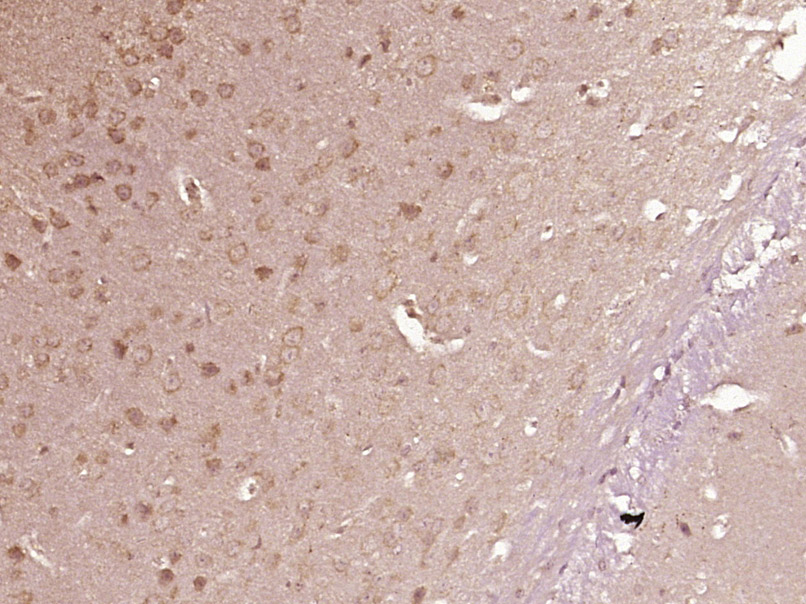PLCD1/NDNC3 Rabbit pAb
PLCD1/NDNC3 Rabbit pAb
- 产品详情
- 实验流程
- 背景知识
Application
| IHC-P, IHC-F, IF |
|---|---|
| Primary Accession | P51178 |
| Reactivity | Pig, Mouse, Rabbit, Horse, Sheep |
| Host | Rabbit |
| Clonality | Polyclonal |
| Calculated MW | 85665 Da |
| Physical State | Liquid |
| Immunogen | KLH conjugated synthetic peptide derived from human PLCD1/NDNC3 |
| Epitope Specificity | 211-310/756 |
| Isotype | IgG |
| Purity | affinity purified by Protein A |
| Buffer | 0.01M TBS (pH7.4) with 1% BSA, 0.02% Proclin300 and 50% Glycerol. |
| SIMILARITY | Contains 1 C2 domain. Contains 2 EF-hand domains. Contains 1 PH domain. Contains 1 PI-PLC X-box domain. Contains 1 PI-PLC X-box domain. |
| DISEASE | The disease is caused by mutations affecting the gene represented in this entry. Disease description:A nail disorder characterized by a white appearance of the nail plate (true leukonychia), the nail bed (pseudoleukonychia), or neither (apparent leukonychia). Leukonychia may involve all of the nail (leukonychia totalis) or only part of the nail (leukonychia partialis), or can appear as one or more transverse bands (leukonychia striata) or white spots (leukonychia punctata). |
| Important Note | This product as supplied is intended for research use only, not for use in human, therapeutic or diagnostic applications. |
| Background Descriptions | This gene encodes a member of the phospholipase C family. Phospholipase C isozymes play critical roles in intracellular signal transduction by catalyzing the hydrolysis of phosphatidylinositol 4,5-bisphosphate (PIP2) into the second messengers diacylglycerol (DAG) and inositol triphosphate (IP3). The encoded protein functions as a tumor suppressor in several types of cancer, and mutations in this gene are a cause of hereditary leukonychia. Alternatively spliced transcript variants encoding multiple isoforms have been observed for this gene. [provided by RefSeq, Dec 2011] |
| Gene ID | 5333 |
|---|---|
| Other Names | 1-phosphatidylinositol 4, 5-bisphosphate phosphodiesterase delta-1, 3.1.4.11, Phosphoinositide phospholipase C-delta-1, Phospholipase C-III, PLC-III, Phospholipase C-delta-1, PLC-delta-1, PLCD1 (HGNC:9060) |
| Dilution | IHC-P=1:100-500,IHC-F=1:100-500,IF=1:100-500 |
| Storage | Store at -20 °C for one year. Avoid repeated freeze/thaw cycles. When reconstituted in sterile pH 7.4 0.01M PBS or diluent of antibody the antibody is stable for at least two weeks at 2-4 °C. |
| Name | PLCD1 (HGNC:9060) |
|---|---|
| Function | The production of the second messenger molecules diacylglycerol (DAG) and inositol 1,4,5-trisphosphate (IP3) is mediated by activated phosphatidylinositol-specific phospholipase C enzymes (PubMed:9188725). Essential for trophoblast and placental development (By similarity). Binds phosphatidylinositol 4,5-bisphosphate (PubMed:7890667, PubMed:9188725). |
| Tissue Location | Strongly expressed in lung, liver and heart. Also expressed at least in pancreas, kidney, skeletal muscle, placenta and brain. |
For Research Use Only. Not For Use In Diagnostic Procedures.
Provided below are standard protocols that you may find useful for product applications.
BACKGROUND
This gene encodes a member of the phospholipase C family. Phospholipase C isozymes play critical roles in intracellular signal transduction by catalyzing the hydrolysis of phosphatidylinositol 4,5-bisphosphate (PIP2) into the second messengers diacylglycerol (DAG) and inositol triphosphate (IP3). The encoded protein functions as a tumor suppressor in several types of cancer, and mutations in this gene are a cause of hereditary leukonychia. Alternatively spliced transcript variants encoding multiple isoforms have been observed for this gene. [provided by RefSeq, Dec 2011]
终于等到您。ABCEPTA(百远生物)抗体产品。
点击下方“我要评价 ”按钮提交您的反馈信息,您的反馈和评价是我们最宝贵的财富之一,
我们将在1-3个工作日内处理您的反馈信息。
如有疑问,联系:0512-88856768 tech-china@abcepta.com.























 癌症的基本特征包括细胞增殖、血管生成、迁移、凋亡逃避机制和细胞永生等。找到癌症发生过程中这些通路的关键标记物和对应的抗体用于检测至关重要。
癌症的基本特征包括细胞增殖、血管生成、迁移、凋亡逃避机制和细胞永生等。找到癌症发生过程中这些通路的关键标记物和对应的抗体用于检测至关重要。 为您推荐一个泛素化位点预测神器——泛素化分析工具,可以为您的蛋白的泛素化位点作出预测和评分。
为您推荐一个泛素化位点预测神器——泛素化分析工具,可以为您的蛋白的泛素化位点作出预测和评分。 细胞自噬受体图形绘图工具为你的蛋白的细胞受体结合位点作出预测和评分,识别结合到自噬通路中的蛋白是非常重要的,便于让我们理解自噬在正常生理、病理过程中的作用,如发育、细胞分化、神经退化性疾病、压力条件下、感染和癌症。
细胞自噬受体图形绘图工具为你的蛋白的细胞受体结合位点作出预测和评分,识别结合到自噬通路中的蛋白是非常重要的,便于让我们理解自噬在正常生理、病理过程中的作用,如发育、细胞分化、神经退化性疾病、压力条件下、感染和癌症。






